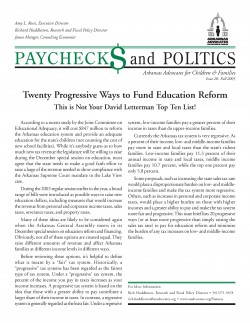
According to a recent study by the Joint Committee on Educational Adequacy, it will cost $847 million to reform the Arkansas education system and provide an adequate education for the state’s children (not counting the cost of new school facilities). While it’s anybody guess as to how much new tax revenue the legislature will be willing to raise during the December special session on education, most agree that the state needs to make a good faith effort to raise a large of the revenue needed to show compliance with the Arkansas Supreme Court mandate in the Lake View case.
During the 2003 regular session earlier in the year, a broad range of bills were introduced as possible ways to raise new education dollars, including measures that would increase the revenue from personal and corporate income taxes, sales taxes, severance taxes, and property taxes.
Many of these ideas are likely to be considered again when the Arkansas General Assembly meets in its December special session on education reform and financing. Obviously, not all of these options are created equal. They raise different amounts of revenue and affect Arkansas families at different income levels in different ways.
Before reviewing these options, it’s helpful to define what is meant by a “fair” tax system. Historically, a “progressive” tax systems has been regarded as the fairest type of tax system. Under a “progressive’ tax system, the percent of the income you pay in taxes increases as your income increases. A progressive tax system is based on the idea that those with a greater ability to pay contribute a larger share of their income in taxes. In contrast, a regressive system is generally regarded as the least fair. Under a regressive system, low-income families pay a greater percent of their income in taxes than do upper-income families.
Currently the Arkansas tax system is very regressive. As a percent of their income, low- and middle-income families pay more in state and local taxes than the state’s richest families. Low-income families pay 11.3 percent of their annual income in state and local taxes, middle income families pay 10.7 percent, while the top one percent pay only 5.8 percent.
Some proposals, such as increasing the state sales tax rate would place a disproportionate burden on low- and middle-income families and make the tax system more regressive. Others, such as increases in personal and corporate income taxes, would place a higher burden on those with higher incomes and a greater ability to pay and make the tax system more fair and progressive. This issue brief lists 20 progressive ways (or at least more progressive than simply raising the sales tax rate) to pay for education reform and minimize the burden of any tax increases on low- and middle-income families.
